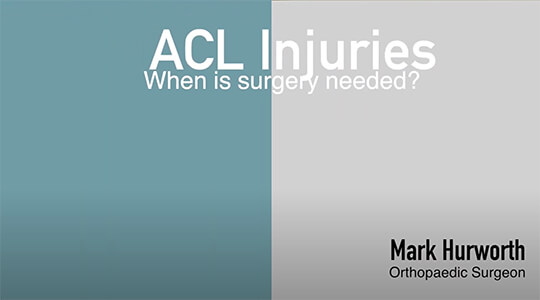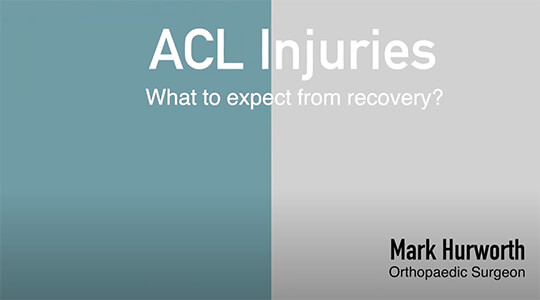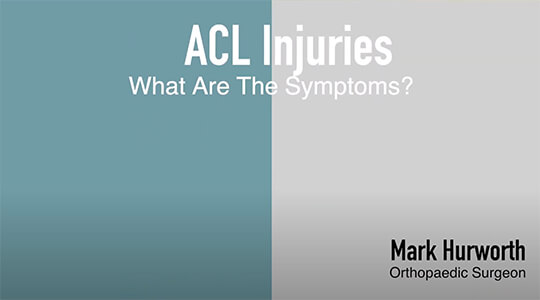ACL Perth
Best treatment options for ACL injury
Below we go over the essential information about ACL injuries, the surgical and non-surgical options and the expected recovery time after ACL surgery.

My orthopaedic practice in a nutshell
ACL injury Perth
What is an ACL injury?
The anterior cruciate ligament (ACL) lies within the knee joint. When the ligament ruptures, it cannot be repaired without surgery.

Mr Mark Hurworth, Knee surgeon Perth
The ACL will typically tear at what we call the proximal end, off the femoral attachment. In rare cases, a partial tear can occur. In order for the ACL to tear, the knee effectively dislocates. Because of this, frequently the diagnosis of ACL injury is associated with a meniscus tear.
In some cases the injury can be more complex with not only meniscus, but also cartilage, or medial or lateral collateral ligaments damage. This may not only add to the complexity of any surgery but also to the length of your recovery time after knee surgery.
Impact of an ACL injury
How does an ACL injury happen, and what are the effects?
The ACL injuries I see in Perth are almost always linked to playing sports or other physical activity. However, the event most often happens without a contact injury eg tackle, but rather in a non-contact situation ie when changing direction while running, or coming down from a jump.
When this injury happens on a sporting field (the knee effectively dislocates) it will often be a dramatic event. There is almost always bleeding into the knee (called haemarthrosis). You may have witnessed professional football players such as Nick Malceski in AFL go down with one and it is painful to watch – let alone to experience it yourself.
If you do not have reconstructive surgery after this type of injury, your knee will often continue to ‘give way’ when you rotate on it in slight flexion. These subsequent injuries can also cause other damage, such as meniscal tearing, which may result in the knee locking up, or clicking and locking sensations.

Mr Mark Hurworth, Knee surgeon Perth
“Every time your knee gives way, it can cause further injury to your knee, with additional swelling or damage to cartilage or meniscus in particular.”
It is often not realised that women are more at risk of ligament injuries – because of hormonal changes and increased ligamentous laxity. I am also seeing higher rates in younger age groups, especially adolescent females, simply because younger people are playing more sport now than previous generations.
It is important to remember that the younger you are when you have an ACL injury, the more likely you are to get injured again. So if you are coming in for an ACL injury as a teenager, it’s good to take this as a warning that you may be overdoing things and that it may be time to slow down.
Story continues below video gallery
Videos about knee conditions and surgeries
Diagnosis of an ACL injury
How is a torn ACL diagnosed?
Typically we go over a few questions about how the injury happened, and what kind of ongoing symptoms you are experiencing. Then I examine the knee, and look for any signs of instability or associated injuries to the meniscus or collaterals.
Additional information will come from an MRI scan, which if often done prior to your first consultation. That way we have all the necessary information available to assess the damage and make a plan for treatment.
ACL reconstruction Perth
Will I need surgery?
What happens if I do nothing? Are there alternatives to surgery? These are always good questions to ask.
The answer really depends on a few variables. Indicators surgery may be required are:
- Other injuries – for instance, if you have meniscal tearing or other injuries at the time of the ACL injury, often you are simply not able to function and surgery is inevitable.
- Age – the younger you are when you have the injury the more likely you are to remain unstable and have recurrent problems.
- Female – more lax knees because of hormonal differences means you are more likely to remain symptomatic without surgery.
- Hopes of returning to competitive sport – if you are serious about your sport, especially contact sports, then you will probably need a reconstruction.
It is always sensible to balance the risks of surgery vs the risks of not having surgery. In this case, you need to consider the risk of future knee arthritis, typically 20 to 30 years after the injury. This type of post-traumatic arthritis is possible even if you have surgery, and is a result of the force of the original injury, often the resulting meniscal injury, and subsequent repetitive “giving way” episodes after the injury occurs.
Having said all this, if you are slightly older, not playing competitive sports, and have an isolated ACL injury on MRI scan, then non-surgical treatment may be perfectly acceptable depending on how much instability you have. Non-surgical treatment is based around strengthening the knee muscles to protect against instability episodes.

ACL Perth & recovery
How does recovery work after ACL surgery?
Recovery is worked out based on your individual injury and circumstances. Timeframes differ if we are talking about returning to regular daily life and work, or a return to contact sports.
Recovery, as always, is closely related to your motivation and compliance. In general, I encourage my Perth patients get on a static bicycle immediately after their injury, to avoid stiffness.

Mr Mark Hurworth, Knee surgeon Perth
“”Getting on a static bike early is what helps you avoid stiffness in the knee. If we were to operate on your knee while it’s too stiff it increases the risk of arthrofibrosis, which is permanent stiffness – a specific risk in ACL surgery.
Typically I do this surgery as a day case ie you go home on the day of surgery. You are on crutches for a few days and sometimes weeks, especially if you have had meniscal surgery (in which case you will also sometimes be in a brace) in addition to the ACL.
The treatment for the first 72 hours is RICE – which stands for Rest, Ice, Compression and Elevation. There is always some bruising and swelling around the knee, and the site of hamstring harvest (posterior thigh) will often be swollen and uncomfortable.
The first priority is getting your knee straight after surgery (extension). Our physiotherapy team will go through this with you.
About 4 months after your surgery, you will be able to start straight-line jogging. For the first three months, you will need to concentrate more on closed chain exercises (static bike, elliptical trainer), because the graft is at its weakest after six weeks. Despite being tissue from your own body, it needs to regrow its own blood supply, and satisfactory strength will typically take 3 months to achieve.
I would not recommend a return to contact or torsional type sports for 12 months after this sort of surgery.
Your recovery is unique, and so is your particular knee injury. We would expect most people with an ACL injury to get back to their pre-injury level over time. But it all depends on other structural damage to your knee. It’s important to be realistic: if you get the injury as a teenager, with strong hopes for a career in elite sports, it can be a devastating event.
Whatever your situation, if you need specialised and experienced help to get an accurate diagnosis and to plan the most suitable treatment of your knee injury, please contact my practice and I look forward to helping you.


